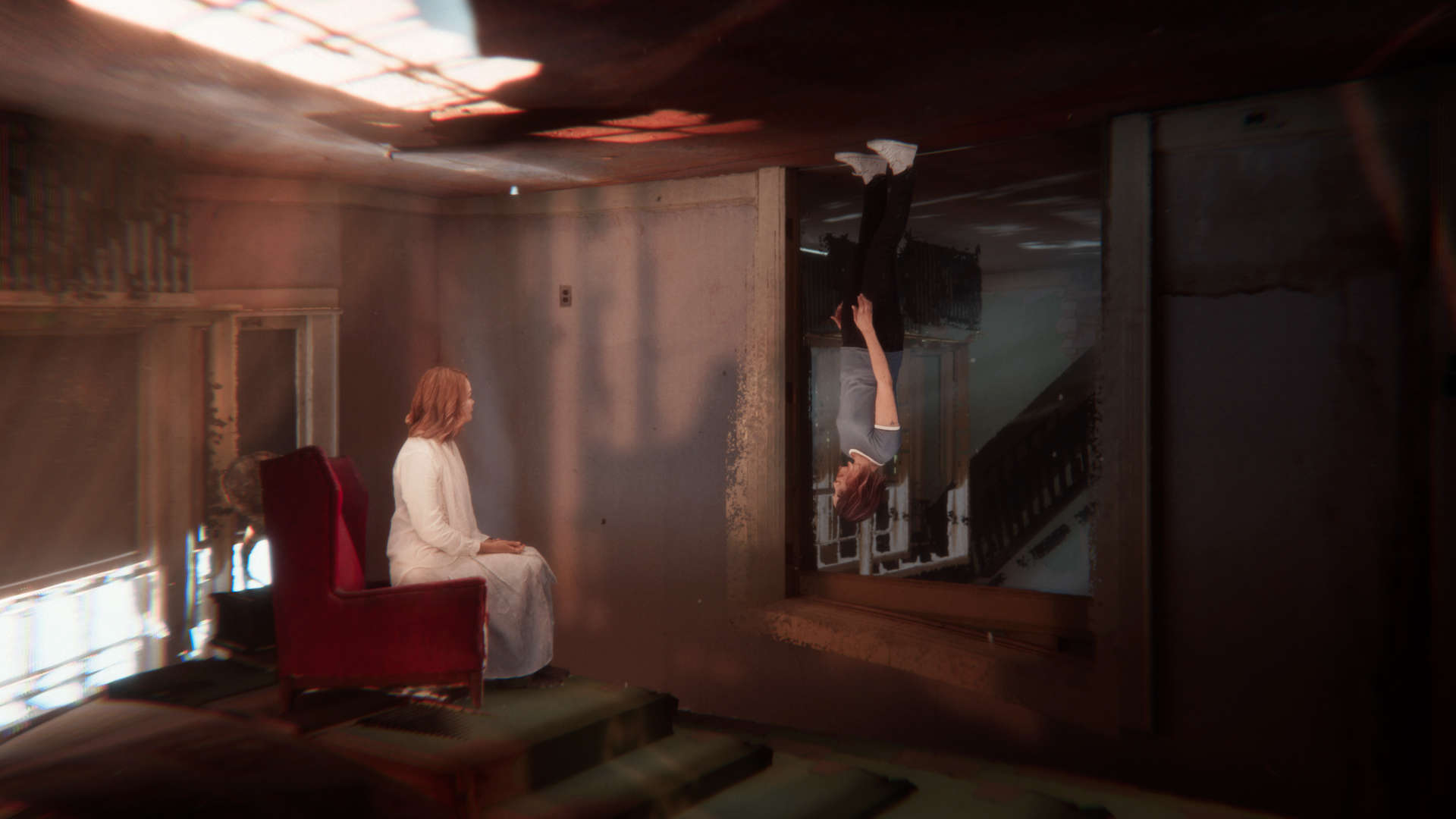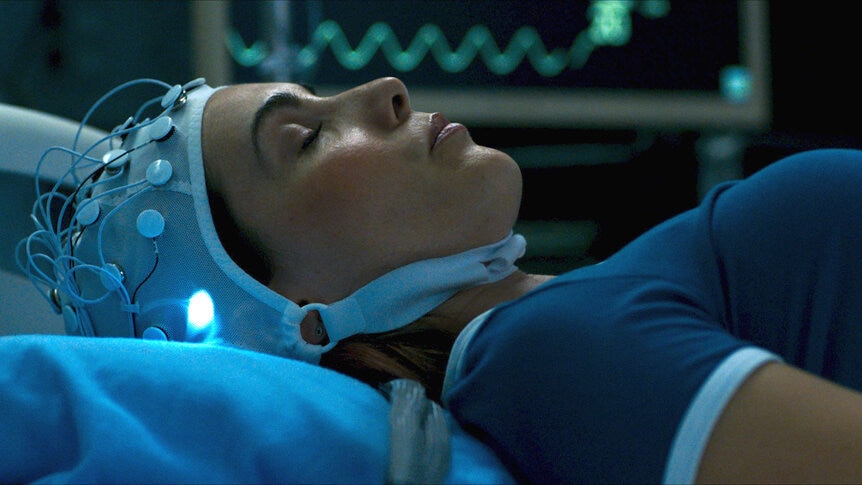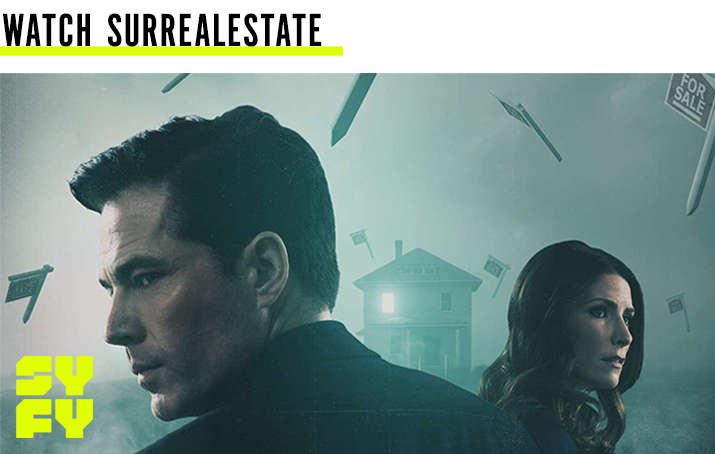Create a free profile to get unlimited access to exclusive videos, sweepstakes, and more!
First Look: How Neill Blomkamp's 'Demonic' broke new ground with its virtual horror show

When Neill Blomkamp set out to make his first horror film, there were a few things he knew for sure. He knew he wanted to work low-budget, he knew he wanted demonic possession to be part of the story, and he knew he wanted to push the envelope of filmmaking technology through the use of "real-time computer graphics." After several years of experimental filmmaking through his company Oats Studios, it was time to move some of that experimentation into the feature-length realm.
"This idea of using volumetric capture and real-time computer graphics was one of the primary reasons I wanted to make the film," Blomkamp told SYFY WIRE. "And because I knew we were making something along the lines of these low budget horror movies, when you combine the idea of wanting to do real-time computer graphics, and then you think of all of these horror movies, when you blend them, it's like: 'Well, let's use the trope of demonic possession, and then what happens with that if we put it into a computer-generated world, what would that look like?' So that started leading to thoughts like, maybe the person who is possessed is in a coma and they're using VR as a way to stretch their legs."
That marriage of technological intrigue and horror storytelling eventually became Demonic, Blomkamp's next feature film, which tells a mother-daughter story rooted in trauma, possession, and fear, with a technological bent that pushes it into science fiction territory. To make the sci-fi element pop, Blomkamp decided to make extensive use of volumetric capture technology, using dozens of cameras all working at once to create three-dimensional renderings of his stars that could then be placed inside the film's virtual world. It's still an emerging technique in the realm of feature filmmaking, and Demonic's virtual horrors made use of it more than any other film to date.
The result is a film laced with sequences that look unlike any other horror movie you'll see this year, as Blomkamp's characters walk through a haunting virtual landscape that, in reality, was represented by a massive cage-like structure of cameras in an otherwise empty room.
"I mean, definitely the most psychologically challenging was the volcap stuff," Blomkamp explained. "The volumetric capture was by far the hardest because the actors are basically in a cage with 260 4K cameras aimed at them, and it's the most unreal, totally synthetic environment you could put an actor in. Even for me, and for the VFX supervisor, I'm trying to picture them in the location that they're going to be in, and then from a technical standpoint, we have to move them through the location."
Shot last summer with a small cast and crew in British Columbia, Demonic tells the story of Carly (Carly Pope), a woman haunted by a traumatic experience in her past linked to her estranged mother Angela (Nathalie Boltt). That past comes calling again when Carly learns that Angela is not just in a coma, but being treated by a company that's testing a new experimental therapy that taps into Angela's brain. Though she's comatose, by putting on a special headset, Carly can actually venture into her mother's mindscape, making contact with the woman locked inside her own body. Once inside, though, Carly finds more than just an awkward reunion with the mother she'd left behind.
To create a clear division between the real world and the mindscape, Blomkamp envisioned a process in which every virtual reality sequence Carly enters would be done through "volumetric capture" or "volcap," which would create real-time, three-dimensional images of the actors as they moved through space. Those images would then be placed inside 3D renderings of real locations, creating a realistic depiction of the prototype virtual reality technology in the film's story. In the gallery below, you can see the step-by-step process of how this all unfolded, from the initial volcap process to early effects work to use a "virtual camera" to frame the scene. Then, finally, there's the finished shot.
To achieve the level of volcap he was looking for, Blomkamp and his team drafted Tobias Chen's company Volumetric Camera Systems, which had already been working at that point with productions including Another Life and Altered Carbon to create volcap scans of actors, often for pre-visualization purposes. When Blomkamp came calling, though, Chen knew he and his team would have to level up.
"When you're doing this kind of volumetric capture of these holograms, what you're doing is, you're doing 30 or 60 3D scans, every single second," Chen explained. "And it's a sequence of 3D scans, not just one 3D scan. And Neill wanted to do these volcap scans of all the actors for every single shutter in the movie. So you would have 3D data of the background and you'd have 3D data of the actors."
To create the backgrounds, producer Mike Blomkamp and his team went out to real physical locations and performed three-dimensional scans of those environments for use in the final product, while Chen and his team began working on the volcap stage for the actors. That's where things got especially tricky.
When you think about actors performing on a blank stage while a crew captures their work to be composited into a film later, you probably imagine something like Avatar or Benedict Cumberbatch crawling across a soundstage to play Smaug in The Hobbit. At this point in filmmaking history, audiences are used to stories of actors performing against nothing for motion capture, so they can be transformed into characters along the way. As Chen explains it, though, volumetric capture is another matter.
"They have the actor wear these mocap suits or put these dots all over their body. And it uses cameras to track only those points. What we did in Demonic is we're not only tracking points, but we're tracking every single pixel on every single point on them. It's tracking every possible thing that the cameras captured, then computing that into a 3D model," Chen said. "So you're not only capturing the movements like you are in Avatar, but you're capturing all the textures, all the geometry, all the clothes, hair, everything all at once. So it's more like you're capturing a hologram of a person rather than just capturing their motions and then applying those motions onto a CG character."
That need to capture everything all at once means that the actor needs to be surrounded by a large framework of cameras, all working at the same time. Because camera resolution naturally works best if an actor is up-close, the further away from each camera the actor is, the trickier a high-resolution image can be, which is why volcap has, until now, typically only centered on one performer in a very small space. For Chen, a key challenge was adapting his system to Blomkamp's desire to go bigger.
"What Neill wanted to do, which was really crazy, was he wanted to scan maybe two people, three people, five people at once," Chen said. "So instead of needing this little one meter space, now we needed a five meter space, which means you need a crapload more cameras. And then all the cameras are so much further from the actor."
He continued, "There's a thing called inverse square law. It's like the further you are away from the source of information, it's not doubling the distance. It doesn't just make it twice as bad. It's actually exponential. Everything gets exponentially worse the further away you are. Because of that, we needed to use so many more cameras to capture this data that it ended up being 239 cameras, all recording 4K video at once. So I think, in the end of it, we captured 400 terabytes of data. So processing that was a challenge, to say the least."
Volumetric Camera Systems' work was eventually sent over to Universal Production Partners in the Czech Republic to create the final visual effects, tweaking the shots, playing with the lighting, and developing the eventual look of the film. When you watch Demonic, some shots might look like you're seeing a particularly gnarly video game glitch as Carly moves through the virtual space of her mother's mind, but according to Blomkamp, that's exactly the point.
"This is exactly why I wanted to use volumetric capture at some point in the movie, because the [low-budget] horror world is a place that would allow you to write the use of volcap into the script in a way where its glitches and errors would be accepted by the audience," Blomkamp said. "It's the only way that you could do it currently, because the technology isn't high resolution enough to narratively justify it within the story. So it's a prototype or it's glitchy or people don't really know what it is, and that's precisely what we did, and then once you've done that then you can kind of just let it be as sh***y as you want it to look, which is exactly my jam."
Though Demonic does spend plenty of its runtime in the real world, the final effect of the volcap process is an eerie journey into another landscape. Within the film's story, it works as an unsettling exercise in sci-fi horror. Within the larger filmmaking world outside of the story, it marks what Chen described as an unprecedented push forward in volcap creativity.
"It was intimidating because no one's ever done anything like this. And the difference between what we were doing, when we were [doing early volcap tests] with just a few dozen cameras versus going all the way to using 239 cameras... pretty much, as far as I know, this is the largest camera array that's ever been constructed in the world. There has never been anyone that's put 239 cameras, all recording into 4K together in one system."
Demonic is in theaters and on-demand on Aug. 20. Check back next week for more of our coverage of the film.
















